What size mountain bike frame do I need? That’s one of the most commonly asked questions by our readers.
Ordering bikes online is becoming more and more popular. Bikes are typically more affordable online than in local bike shops because overhead costs are lower, allowing online stores to sell their bikes at cheaper prices.
But what about the good old rule that says you need to try a bike before buying it? While this can be beneficial, it’s often an overrated method and not necessary for everyone.
If you go to a local bike shop and sit on a bike, you’re more likely to buy it, which is why shopkeepers would like you to do it. But the reality is that most novice riders don’t know how a bike should feel during their first test ride, so this sizing method is not valuable for inexperienced riders.
You should try your bike first! Not completely true!
Even though everyone is built differently, most people’s bodies fall into certain categories in terms of height, inseam length, and arm length. Therefore, unless you’re have an unusual ratio of upper and lower body length, you can trust mountain bike size charts to recommend you the right frame size.
Related: Best Mountain Bikes You Can Get
With that in mind, there are several reliable methods to choose the right mountain bike frame size.
In this article, I’m going to show you how to use mountain bike size charts and online calculators to get the right size and fit in seconds!
Contents
Method #1: Mountain Bike Size Chart
The easiest way to find the correct bike size is by using a mountain bike frame size chart. This is a simple method that lets you compare your height and/or inseam length against a chart that recommends the correct frame size.
Mountain bike frame sizes are measured based on seat tube length, expressed in inches, which typically ranges from 13″ to 24″. Effective top tube length (the horizontal distance between the head tube and the seat tube) plays a role as well, but seat tube length is a more common measurement.
Some manufacturers also use size classes, such as XS, S, M, L, and XL, but these are not as reliable as using inches because the measurements can differ from one brand to another.
What mountain bike frame size do I need? Find the answer in the chart below:
| Rider Height | Suggested Mountain Frame Size | ||
| Feet & Inches | Centimeters | Frame Size (inches) | Size Classes |
| 4’10” – 5’2″ | 148cm – 158cm | 13″ – 14″ | X-Small |
| 5’2″ – 5’6″ | 158cm – 168cm | 15″ – 16″ | Small |
| 5’6″ – 5′ 10″ | 168cm – 178cm | 17″ – 18″ | Medium |
| 5’10” – 6’1″ | 178cm – 185cm | 19″ – 20″ | Large |
| 6’1″ – 6’4″ | 185cm – 193cm | 21″ – 22″ | X-Large |
| 6’4″ – 6’6″ | 193cm – 198cm | 23″ – 24″ | XX-Large |
Bonus tip: If you’re buying a bike on Amazon, you can also check out their Amazon Fit Guide which includes sizing recommendations for adult road bikes, adult mountain bikes, and kids’ bikes.
Related: Best Gravel Bikes You Can Buy
Method #2: Online Bike Size Calculator
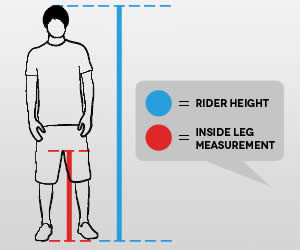 The next best way to find the right mountain bike size based on your height and inseam length is to use an online bike size calculator.
The next best way to find the right mountain bike size based on your height and inseam length is to use an online bike size calculator.
These are interactive tools that let you enter your height and inseam length and then recommend you the correct size or range of sizes to consider.
Before you can use one, you need to learn how to correctly measure your inseam. Here’s a quick step-by-step guide:
- Take off your shoes and stand with your legs 6″ to 8″ (15-20 cm) apart.
- Place a book between your legs, as far up as you can.
- Measure the length from the ground up to the top of the book.
- Voila! This is your inseam length that you can now enter into an online bike size calculator.
When using a bike size calculator, make sure to choose the right type of bike—mountain bike, city bike, or road bike—as the measurements will differ based on that.
If you’re not sure about it, you can read more about the different bike types here.
Here are the top online bike frame size calculators we recommend:
1. Ebicycles.com Online Calculator: An easy way to find the right MTB frame size by using your height and inseam length.
2. Competitive Cyclist Fit Calculator: A more detailed bike fit calculator that lets you know the correct standover height range, top tube length, saddle height, and more.
3. Jenson USA Bike Fit Calculator: Another in-depth bike fit calculator that suggests the right bike size and helps you nail the fit afterward.
Method #3: Mountain Bike Sizing Formula
One of the easiest but also the least reliable methods of finding the right mountain bike size is using a simple mathematical formula that uses your inseam length.
It goes like this:
Leg inseam (cm) x 0.66 = Your frame size
For example, if your leg inseam is 76cm, multiplied by 0.66 then your correct mountain bike size is 20″ (50cm).
This method is only good for approximating the correct size, but we don’t recommend relying on it exclusively. It’s best to combine it with the results you get from the mountain bike size chart and online calculator that we’ve shown you above.
Bonus Tip: Finding the Right Saddle Height
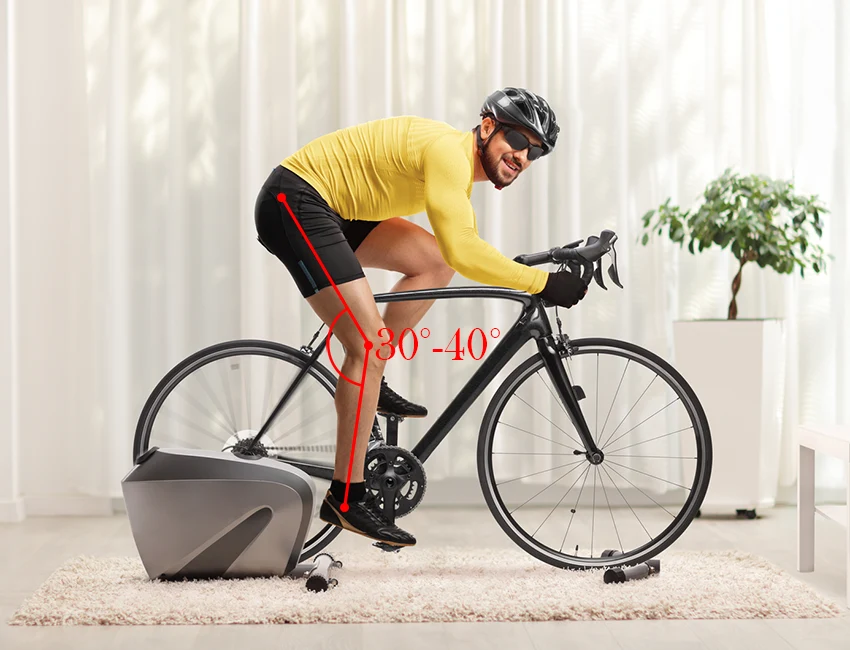
Setting the saddle height correctly has a very important impact on the overall bike fit.
If the saddle height is too low, you won’t be able to transfer power to the pedals effectively and your legs may fatigue more quickly. I have experienced that firsthand in mountain bike racing—when the saddle falls down by one inch from its ideal position, I lose about 25-50% of my power.
Now that we know how important finding the perfect saddle height is, how should we do it?
The easiest way is to:
- Hop on your bike wearing the shoes that you typically use for cycling (flat or clipless).
- Lean against the wall for support or have someone help you stay in an upright position. You can also use a bike trainer for this purpose.
- Push the pedal down to its lowest point (6 o’clock) while keeping the foot parallel to the ground.
- At this point, you should have a slight bend in the knee, as shown in the image above. Adjust the saddle height accordingly until you achieve it.
The next step is to go outside and ride. Does it feel good? If not, then make further minimal adjustments (a few millimeters at a time) until the saddle height feels natural, your power transfer is optimal, and you’re not feeling any pains or aches.
Related: Check Out The Best Fat Tire Bikes
 Bicycle Guider’s TIP:
Bicycle Guider’s TIP:
Once you’ve determined your ideal saddle height, it’s a good idea to mark that position with a marker, as saddles can lower with time. Some bikes come with height indicators on the seat post, so make sure to remember the correct marking for future reference.
MTB Geometry Guide
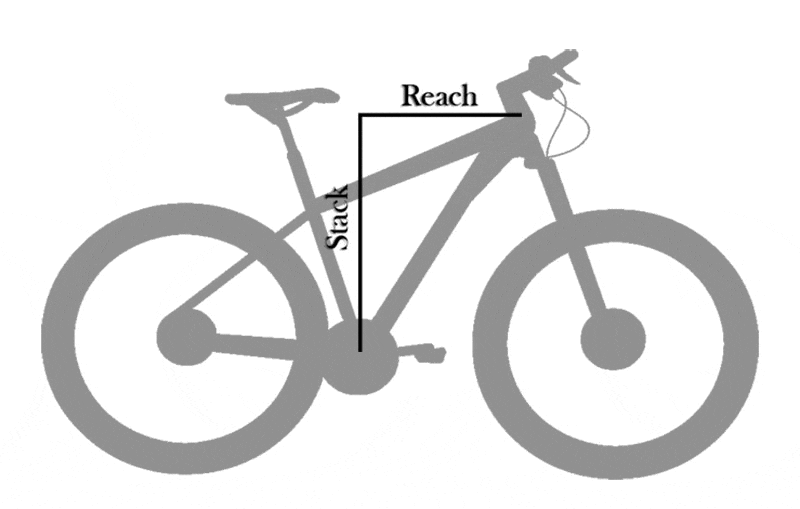
Mountain bike geometry refers to the actual shape of the bicycle, the measurements of different tubes and angles, and their relations to each other.
Here’s a brief guide on the most important measurements you need to be aware of to get the right fit:
- Reach: This measurement refers to the horizontal distance between the center of the bottom bracket to the top center of the head tube. It affects the length of the bike and the overall stability and ride feel.
- Stack: Refers to the vertical distance between the center of the bottom bracket to the top center of the head tube. It affects how upright your position will be and how tall the handlebar will be.
- Standover height: This is the height from the ground to the top of the top tube. Make sure that this measurement is at least an inch shorter than your inseam length to be able to stand over the bike with both feet flat on the ground.
- Wheelbase: This is the distance between the centers of both wheels. A shorter wheelbase provides more agility, while a longer wheelbase improves stability.
- Head tube angle: This is the angle between the ground and the bike’s fork. A slacker angle (lower number) means the bike is more stable on rough terrain, while a steeper angle allows more responsive steering.
- Seat tube angle: This measurement refers to the angle between the ground and the seat tube. A steeper angle improves climbing ability, whereas a slacker angle is better for descending.
How to Choose When In-Between Two Sizes?
So you’ve consulted a mountain bike size chart or an online calculator and the results put you right in the middle of two sizes. What do you do? Should you size up or size down?
Each option has some pros and cons and the final decision depends on your:
- Flexibility
- Leg-to-torso length ratio
- Riding style
Here are some of the most important factors to consider when deciding whether to get a one size bigger or smaller mountain bike.
When to Size Up?
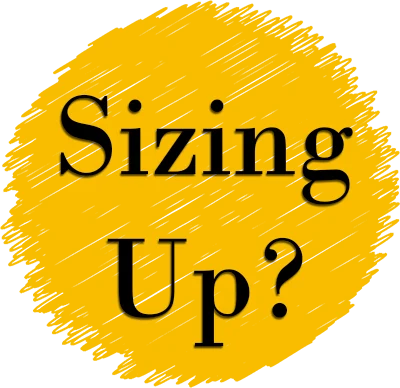
Mountain bikes grow in length (reach) and in height (stack) with each frame size. But modern mountain bikes grow more in length (reach), which is why this is a more important measurement to consider.
Assume you are in between two sizes and you decide to size up. You’ll get a bike with a longer top tube and a longer wheelbase, which means your handlebar will be further away from the saddle.
How does this affect the factors we’ve mentioned above?
Flexibility: This is a good option for riders who are flexible and can easily reach their toes when bent over. A longer top tube means you will need to hinge more at the hips, which can be painful and uncomfortable if you’re stiff and have a short range of motion.
Leg-to-torso length ratio: If you have short legs and a long torso, you should size up when buying a mountain bike as this will give you a more neutral fit. But make sure that the standover height is not too high so that you can’t stand over the bike comfortably.
Riding style: Finally, a larger frame size translates to a longer wheelbase, which means the bike will be more stable on rough terrain and go over obstacles with more ease, but it will feel less playful and more difficult to maneuver.
When to Size Down?
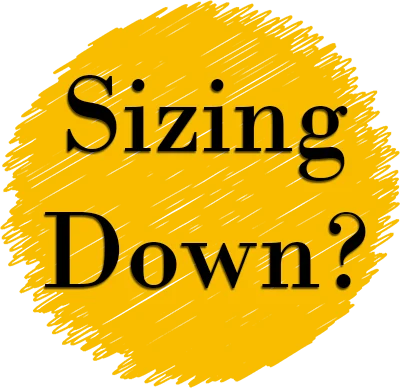
Similarly, a smaller mountain bike will have a significantly shorter reach and a slightly shorter stack and wheelbase. A smaller bike will also have a shorter maximum seat post height, so you may need to extend it depending on how long your legs are.
So how does this relate to the three most important factors mentioned above?
Flexibility: If you are not a flexible person and you struggle to reach your toes with your fingers, then you’ll benefit from a shorter reach a smaller mountain bike frame size offers. It will put you in a more upright riding position, with handlebars closer to your body, which means you can ride for longer without experiencing discomfort.
Leg-to-torso length ratio: Sizing down is a logical choice for riders who have longer legs and shorter torsos. This way, the bike will feel more comfortable, but you may need to use a longer seat post to get the proper leg extension.
Riding style: A smaller mountain bike with a shorter wheelbase will feel more nimble, playful, and easier to handle over rough terrain. If you like flicking your rear wheel and going around obstacles instead of plowing through them, a smaller bike is the right choice.
What If I Still Got the Wrong Bike Size?
Sometimes, even after going through all the methods and consulting several mountain bike size charts, you may find that the bike doesn’t feel right and that you’ve probably chosen the wrong bike size.
Don’t worry, if you’re off by one size or even half a size, there are easy fixes you can try to improve the comfort and fit!
The first thing to do is to contact the retailer/manufacturer and try to get a replacement. Under the right conditions, you’ll be able to get a different frame size bike without significant additional costs.
If you don’t want to go through the hassle of shipping the bike or this option is not available, you can try the following things:
- Adjust the fore-aft position of the saddle: The fore-aft position of the saddle can be adjusted slightly to lengthen or shorten the reach. Make sure not to overdo it so your knee doesn’t end up too far in front or behind the middle of your foot when in the 3 o’clock position.
- Replace the stem: By using a longer or a shorter stem, you’ll be able to increase or shorten the reach by a few centimeters. In most cases, this will be enough to significantly improve the feel and ride quality.
- Replace the seat post: If you bought a bike that is too small and you can’t extend the leg fully when pedaling, consider using a longer seat post.
- Replace the handlebar: A shorter handlebar will be easier to reach and will put you in a less stretched-out position and vice-versa. If you’re using drop bars, consider getting a model with a shorter or longer reach to fine-tune your fitment.
- Raise the handlebar: You can easily achieve a more upright riding position and increase the stack measurement by raising the handlebar with headset spacers. If there are headset spacers above your stem, simply move them underneath to move the stem and handlebar higher up.
- Get a professional bike fitting: A professional bike fitter can do all of these steps for you, which is the best option you have, but also the costliest.
Most importantly, give yourself time to get accustomed to your new bike. Sometimes, your body needs a few days or weeks to adjust to the new riding position.
I remember when I got my first 29er mountain bike. It felt huge and I found it difficult to ride it on narrow winding trails and on technical terrain. However, now that I’m used to the 29er, the 26″ mountain bike seems almost comically small.
Mountain Bike Reviews
Are you in the market for a new mountain bike? Start with one of our mountain bike buying guides below:


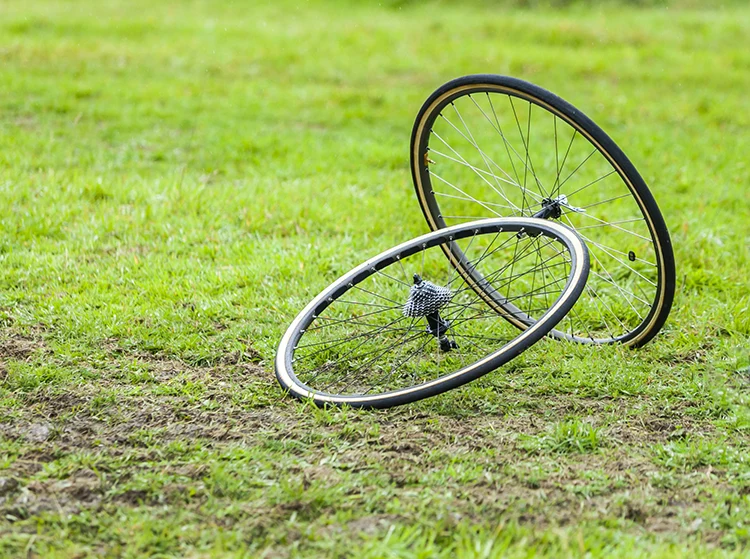
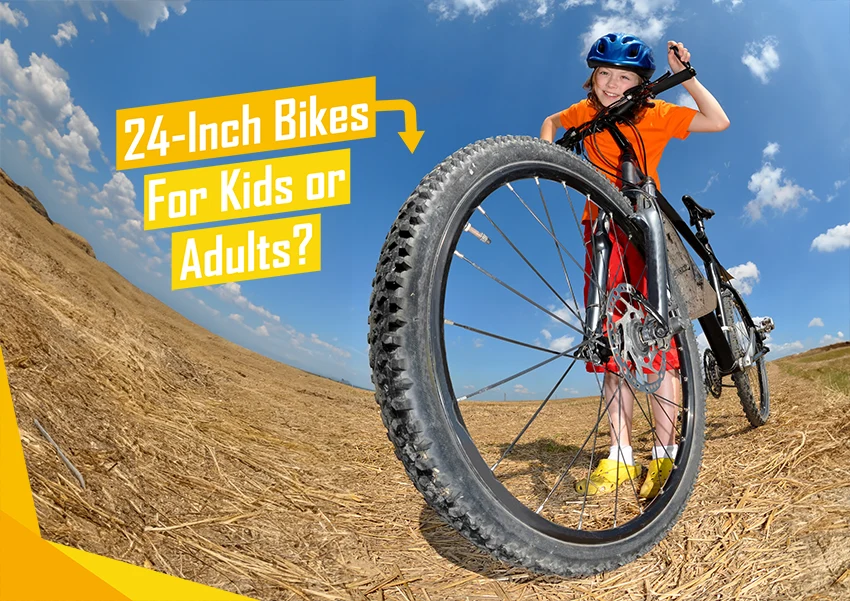
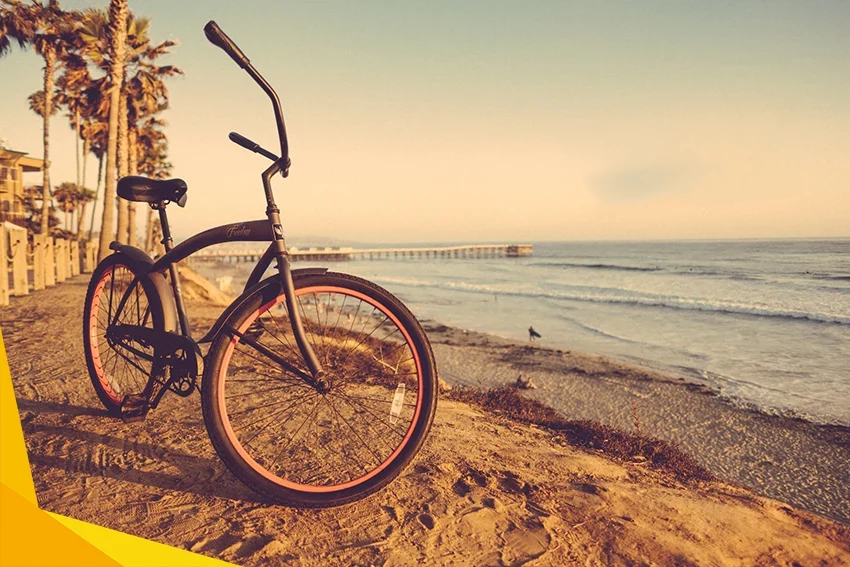
Hello!
I’m trying to decide what size for REI’s co op 2.1 DRT. There is no info on frame size just reach and stack and I’m unsure what those are?
I’m female 5’9” 145ish lbs and my legs are a few inches longer than my torso. I’m having a difficult time deciding because I am in between sizes and the Medium comes with 27.5 in tires and Large has 29s. I plan to ride lots of trails in desert and forest areas. I will try both out if possible but any advice would be greatly appreciated! c:
Medium : 453 reach , 594 stack
Large : 478 reach , 617 stack
My inseam: 33in
My arm length from top of arm to wrist : 26in
Not sure if this helps lol
Hi Tess,
Stack is the vertical distance from the center of the bottom bracket to the midpoint at the head tube. Reach is the horizontal distance from the center of the bottom bracket to the middle of the head tube.
The rule of the thumb is this: find a recommended frame for your size. For example, the medium is a recommended frame size for you. However, there is no perfect fit when it comes to our bodies. That is why bike fit is still important. For people with longer arms then you can make an adjustment in terms of the stem length or your saddle fore and aft etc.
All this info about frame size but not a word on wheel size.
Example: which is for a taller person, a 19″ frame with 27″ tires or a 20″ frame with 26″ tires.
To get the right size bike you need to consider both .
I feel you need to explain the relationship between the two
Hi Angryhippi,
Thanks for the feedback. We will look into this. However, if you look at all the bike sizes from different websites, the frame is always the standard.
Hey Dave, I’m 5’4″ 31 inch inseam. Everything steers me to a small frame but they just feel so small and compact. The bike I’ve looked at is the Santa Cruz Hightower. Suggestions
Hi Claire,
You fall on a small frame recommendation. There are other things to consider other than the recommended frame size and this is where bike fit comes into play. For example, you can always adjust the bike fit by getting a longer or shorter stem, the saddle fore & aft, stem height, and also handlebar sweep or angle. So, don’t worry if the frame seem so small. You won’t know if it is comfortable until you try it and get a proper bike fit. In fact a smaller frame (in general) gives you more control of the bike.
Doesn’t make sense. I’m 6’2 so should have a 21 inch mtb but my inseam is 33″ so I should have an 18″-19″ mtb.
I can never get the right size bike which is comfortable for riding
Hi Rick,
You are not the only one. The chart can provide you with the standard size for your height but that is not the end of it. You need to make adjustments in terms of saddle fore & aft, crank length, stem length etc. That is why a bike fit is recommended. I once bough a smaller frame that my recommended size but after making changes in the stem, saddle, handlebar etc, no issues felt.
26frame cycle wheel and 26wheel size
Then how it’s is medium or large I need make taller
Hi Rahul,
Do mean to make the bike fit your size? I assume you are taller than the recommended frame, but do correct me if I am wrong. You can make adjustments like increasing the saddle height, moving the saddle back, and increasing your stem length. However, getting a proper bike fit is more effective.
Thanks for a wonderful article. This is really helpful! I’m 5’5″ in height and cosidering purchasing an RB and MTB. Should I get both small size?
Hi Chris,
Just choose a frame that’s medium size-for both. Then consider getting a proper bike fit. Good luck! Do let me know what happens.
Hi Jeff – great article – but I’m still a little confused and stuck between size decision!
I’m 5′ 9 with a 31 inside leg and I think this means I should be looking for a L mountain bike, however the bike I’m looking at seems a little high from a standover perspective, it’s an On-one Scandal from here:
https://www.planetx.co.uk/i/q/CBOOSCGX/on-one-scandal-sram-gx-mountain-bike
Do you think the L will be fine or better with M? The M is 16.5″ and L is 18″.
Hi David,
A large frame is best suited for you. 18″ is perfect. Do make adjustments on the stem length and saddle fore & aft if you can.
I’m 5,7 w/ 30”” inseam. Can I ride a 13” trek navigator 3.0
Hi Tina,
5’7 belongs to the medium size under the road bike category. I am not sure what you mean about the 13″ but your frame sizes are 54-55 cm.
Hello, I already ordered Marin Bobcat Trail 3 XL frame size , im 6.13 tall 205lbs.. Do you think it´s gonna be good size for me?
This size chart make me feel good but im overthinking about that..
https://www.marinbikes.com/bikes/2021-bobcat-trail-3
Hi Jakub,
Yes that size can accommodate you because it still falls under your height. Make sure to have a bike fit for those little adjustments that will make your riding experience a comfortable one.
i have a trek fuel ex 8. large frame. my seat height is just over three inches higher than my handlebars. feels very awkward. all my weight feels like its on my arms. i have a lot of trouble with front tire washing out
Hi Tim,
Try to lower the seatpost and test the ride. You also need to adjust the saddle angle. Having a perfect horizontal saddle angle will prevent your body weight being pushed to your hands.